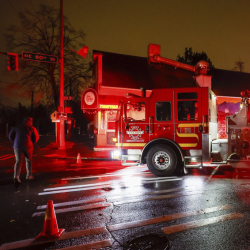 When Mexico held its first presidential debate on May 6, it was caricatured publicly as a contest between a "Pretty Boy" (Enrique Peña Nieto), a "Quinceañera Doll" (Josefina Vázquez) and a "Has Been" (Andres López Obrador).
When Mexico held its first presidential debate on May 6, it was caricatured publicly as a contest between a "Pretty Boy" (Enrique Peña Nieto), a "Quinceañera Doll" (Josefina Vázquez) and a "Has Been" (Andres López Obrador).
At the time, Peña Nieto, of the Institutional Revolutionary Party (PRI), was the candidate to beat, leading both Vázquez, of the incumbent National Action Party (PAN), and López Obrador, of the Democratic Revolution Party (PRD), by more than double digits in opinion polls.
Of the three, López Obrador was considered the long shot, largely written off in Mexico's mainstream media as a tired leftist stalwart. López Obrador was the old man, the sore loser – he lost the presidential election by a controversially slim margin in 2006 – and the candidate with a head full of socialist ideas that had long ago been discredited.
But today, with only three weeks of campaigning to go before Mexicans elect a new president, López Obrador – known in Mexico by his initials, AMLO – has moved into a statistical tie for first place with Peña Nieto.
The political resurrection of AMLO has stunned observers, with the prospect of a leftist government being elected in Mexico now a real possibility.
The sudden ascendance of AMLO is the unintended consequence of a grassroots and mostly student-led protest and social media campaign that sprung up more than two weeks ago as a reaction to and condemnation of Mexico's "old media" – the major television stations like Televisa and newspapers that have long represented Mexico's elite – and their perceived role in pandering to the interests of the PRI.
After being booed off the stage by students at a university appearance two weeks ago, Peña Nieto did little to help his case when he belittled the uproar in the media, proclaiming it to be the product of "131 malcontent" students. That comment resulted in spontaneous street protests in Mexico City that utilized the slogan, "Yo Soy #132" (I Am #132), a catch phrase that quickly went viral on YouTube, Twitter and FaceBook.
"It was about time that Mexico woke up, that it stopped watching television," Leonardo Mata, a student at Mexico City's Metropolitan Autonomous University who participated in a rally that grew to almost 45,000 participants on May 24, told CNN Mexico.
The protester's allegations of favorable coverage by the largest television network, Televisa, on behalf of the PRI's Peña Nieto, were confirmed on June 7 when The Guardian published a budget and schedule of payments by the PRI to Televisa totaling more than $22 million USD.
The revelations created a major crisis for Peña Nieto and the PRI, with only three weeks left before Mexicans head to the polls.
With The Guardian report, the Yo Soy #132 student movement was vindicated, and there is even some speculation that Peña Nieto may have to withdraw from the election. Rallies and demonstrations are being planned for this weekend and next week to force Peña Nieto to withdraw.
The student uprising, which has been called Mexico's version of the "Arab Spring," is actually something altogether different: Where the Middle East demonstrations sought to overthrow unpopular regimes from power, in Mexico they are designed to prevent a political party – the PRI – from re-gaining power.
That's quite a difference. Yet the important role of social media in each movement is undeniable.
Students in Mexico took to social media to spread a simple message using Enrique Peña Nieto's initials: "Este Pendejo No," meaning "Not This Asshole." In other words, any other asshole would do.
It was just the opening that AMLO needed. While Peña Nieto and the PRI have been paralyzed by the student uprising – Nieto recently withdrew from the third presidential debate scheduled for June 19 -- AMLO's campaign has seized on the opportunity.
AMLO's strategy has been two-fold. First, he proposed the creation of a "República Amorosa," or "Loving Republic," that would restore the moral values of Mexican society to solve the nation's ills. Presented as "AMLOVE," the idea was to create a national conversation among business, religious leaders, and academics to find sustainable solutions to Mexico's problems based on humanistic ideals.
Second, AMLO has focused his relentless criticism on the "state of insecurity" and "corruption" in Mexico, as a consequence of the War on Drugs. Playing to Mexican's fatigue over the daily body count splattered on the front pages of newspapers and television news reports, AMLO has found tremendous resonance among a public that is exhausted by the emotional stress of the War on Drugs. Indeed, Mexico, for the first time, is confronting the reality of a large number of people showing symptoms of post-traumatic stress disorder, known as TEPT in Spanish. Since 2008, studies have documented TEPT in Mexican children as young as 8 years of age.
In Spain, the largest newspaper, El País, has hailed "the resurrection" of AMLO, and the most recent opinion polls by the Mexican newspaper Reforma put Peña Nieto at 38 percent, with AMLO at 34 percent, within the margin of error. This represents a surge of 10 percentage points in less than two weeks after the Yo Soy #132 student movements began.
AMLO's rise has rattled Mexico's business class, which fears he would follow through on his promises – or threats – of imposing a Venezuela-style economic program of nationalization and social engineering. AMLO has had to reassure the public he is not intent on pursuing a Hugo Chavez-style government in Mexico if elected.
None of this has been reassuring, and the students who are part of the Yo Soy #132 movement are not sure of what to make of the fact that their protests against the PRI's Peña Nieto are paving the way for what has become the most highly-contested presidential election in a generation.
As recently as April, Mexicans were resigning themselves to the PRI's return to power, but now all bets are off.
Mexican students may get their wish – Not This Asshole (Peña Nieto) -- after all, but it's still not clear how Mexico will fare should AMLO ride the coattails of their uprising to the presidency.
Portland and Seattle
Free Subscription to Breaking News
Free Subscription to Breaking News





















































































































































































































































































































































